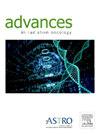基于知识质量保证工具的儿童颅脊柱辐照图谱与神经网络自分割方法的比较分析
IF 2.7
Q3 ONCOLOGY
引用次数: 0
摘要
目的评估Atlas和神经网络自动分割方法的性能,开发基于知识的儿童颅脊髓照射(CSI)质量保证(QA)工具。方法和材料采用Atlas、商业人工智能(AI)和内部人工智能(AI) 3种方法对63例CSI患者进行自动分割。使用13个定量指标(包括6个重叠指标和7个距离指标)对13个关键器官的这些方法的性能进行了分析,并进行了线性混合效应模型分析。此外,通过利用来自100名CSI患者的每个器官的不同计算机断层扫描数量分布,使用核密度估计(KDE)方法开发了基于知识的QA工具,以确保稳健的错误检测和验证。通过比较100名CSI患者的基线kde,在50例CSI病例中测试了QA工具。结果线性混合效应分析表明,内部人工智能在重叠和距离指标上优于Atlas和商业人工智能方法。内部人工智能的平均重叠度为0.01±0.01,优于商业人工智能,超过Atlas方法0.02±0.01。在距离度量方面,内部人工智能与商用人工智能(-0.31±0.72 mm)相当,比Atlas方法高出3.10±0.68 mm。配对t检验显示,在13.0%的情况下,内部人工智能优于Atlas,而Atlas在8.9%的比较中优于内部方法。同样,内部人工智能在35.3%的测试中优于商业人工智能,商业人工智能在32.7%的测试中优于商业人工智能。QA工具结果表明,46.4%的Atlas测试、46.5%的商业AI测试和60.7%的内部AI测试与基线kde 100%一致。结论室内人工智能在儿童CSI患者的自动分割精度上优于Atlas和商业人工智能方法。此外,基于知识的QA工具使临床医生能够检测和纠正自动分割中的严重错误。本文章由计算机程序翻译,如有差异,请以英文原文为准。
Comparative Analysis of Atlas and Neural Network Autosegmentation Methods for Pediatric Craniospinal Irradiation With the Development of a Knowledge-Based Quality Assurance Tool
Purpose
This study aims to evaluate the performance of Atlas and neural network autosegmentation methods and develop a knowledge-based quality assurance (QA) tool for pediatric craniospinal irradiation (CSI).
Methods and Materials
Autosegmentation was performed on 63 CSI patients using 3 methods: Atlas, commercial artificial intelligence (AI), and in-house AI. The performance of these methods was analyzed using 13 quantitative metrics, comprising 6 overlap and 7 distance metrics, across 13 critical organs and a linear mixed-effect model analysis was performed. Additionally, a knowledge-based QA tool was developed by leveraging distinctive computed tomography number distributions from 100 CSI patients for each organ, using the kernel density estimation (KDE) method to ensure robust error detection and validation. The QA tool was tested on 50 CSI cases by comparing baseline KDEs from 100 CSI patients.
Results
The linear mixed-effect analysis showed that the in-house AI outperformed both the Atlas and commercial AI methods in overlap and distance metrics. The in-house AI outperformed the commercial AI with a higher average overlap of 0.01 ± 0.01 and surpassed the Atlas method by 0.02 ± 0.01. In terms of distance metrics, the in-house AI matched the commercial AI (–0.31 ± 0.72 mm) and exceeded the Atlas method by 3.10 ± 0.68 mm. Paired t-tests showed the in-house AI was superior to the Atlas in 13.0% of cases, while the Atlas outperformed the in-house method in 8.9% of comparisons. Similarly, the in-house AI was better than the commercial AI in 35.3% of tests, with the commercial AI outperforming in 32.7%. The QA tool results demonstrated that 100% agreement with baseline KDEs occurred in 46.4% of tests for Atlas, 46.5% for the commercial AI, and 60.7% for the in-house AI.
Conclusions
The in-house AI excelled over the Atlas and commercial AI methods in autosegmentation accuracy for pediatric CSI patients. Furthermore, a knowledge-based QA tool enables clinicians to detect and correct gross errors in autosegmentation.
求助全文
通过发布文献求助,成功后即可免费获取论文全文。
去求助
来源期刊

Advances in Radiation Oncology
Medicine-Radiology, Nuclear Medicine and Imaging
CiteScore
4.60
自引率
4.30%
发文量
208
审稿时长
98 days
期刊介绍:
The purpose of Advances is to provide information for clinicians who use radiation therapy by publishing: Clinical trial reports and reanalyses. Basic science original reports. Manuscripts examining health services research, comparative and cost effectiveness research, and systematic reviews. Case reports documenting unusual problems and solutions. High quality multi and single institutional series, as well as other novel retrospective hypothesis generating series. Timely critical reviews on important topics in radiation oncology, such as side effects. Articles reporting the natural history of disease and patterns of failure, particularly as they relate to treatment volume delineation. Articles on safety and quality in radiation therapy. Essays on clinical experience. Articles on practice transformation in radiation oncology, in particular: Aspects of health policy that may impact the future practice of radiation oncology. How information technology, such as data analytics and systems innovations, will change radiation oncology practice. Articles on imaging as they relate to radiation therapy treatment.
 求助内容:
求助内容: 应助结果提醒方式:
应助结果提醒方式:


